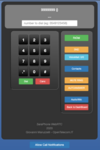Just a hunch, but if your target platform is mobile a browser based phone may not be worth the effort. The below is from Microsoft's Copilot and feels okay, but do be warned that copilot has given me some nonsensical and absolutely bananas answers before:
Certainly! Let’s explore how
web push notifications work on mobile devices, especially when the phone is not actively in use:
- Web Push Notifications on Mobile Devices:
- Web push notifications are a widespread and effective communication channel used by more than eight percent of top websites.
- These messages allow websites to reach users with timely and personalized alerts even after they’ve left the website.
- Web push notifications are displayed on a visitor’s desktop, tablet, or mobile device when they have their web browser open.
- When a user clicks on a web push notification, they are sent to a URL defined by the company.
- On mobile devices, these notifications appear similarly to desktop notifications.
- Mobile Push Notifications vs. Web Push Notifications:
- Mobile push notifications take a different path to delivery:
- They are sent directly to a device’s operating system (iOS, Android).
- They are contingent on your company having a mobile application.
- Unlike web push notifications, which are seen only by users currently active on the device, mobile push notifications can appear on a user’s lock screen regardless of their activity.
- They are critical for reengaging users who may be engaged with other activities.
- Opt-In Permission:
- The web push channel is supported by Android and iOS devices.
- Some browsers that currently support mobile push notifications include Chrome, Firefox, and others.
- The protocol for subscribing to mobile web push is similar to desktop web push, with minor differences in custom permission prompts and native browser permission displays.
- Sending Web Notifications:
- Companies must integrate with a web push service to send these messages.
- Popular browsers like Chrome, Firefox, Safari, Edge, and Opera support sending web push notifications.
- Appearance of web push notifications may vary across browsers.
In summary, web push notifications can reach users on mobile devices, but they rely on the user’s browser being open. Mobile push notifications, on the other hand, can appear even when the app is not actively running, making them valuable for reengagement.


